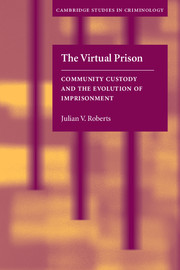Book contents
- Frontmatter
- Contents
- List of figures and tables
- Foreword by Andrew Ashworth
- Preface
- 1 Introduction to the concept of community custody
- 2 The way we punish now
- 3 Conceptualizing community custody
- 4 Representative models of community custody
- 5 Coming home to prison: offender perceptions and experiences
- 6 The effect of community custody on prison admissions
- 7 Public attitudes to community custody
- 8 Making community custody sentences work
- Notes
- References
- Index
5 - Coming home to prison: offender perceptions and experiences
Published online by Cambridge University Press: 07 December 2009
- Frontmatter
- Contents
- List of figures and tables
- Foreword by Andrew Ashworth
- Preface
- 1 Introduction to the concept of community custody
- 2 The way we punish now
- 3 Conceptualizing community custody
- 4 Representative models of community custody
- 5 Coming home to prison: offender perceptions and experiences
- 6 The effect of community custody on prison admissions
- 7 Public attitudes to community custody
- 8 Making community custody sentences work
- Notes
- References
- Index
Summary
The views of offenders were not often considered in studies of the criminal justice system. There appears to be a certain unspoken agreement that having been sentenced … the views of the individual so dealt with are irrelevant.
(Mair and Nee, 1990, p. 52)This chapter approaches the phenomenon of community custody from the perspective of the people most affected by the sanction: offenders and their families. The voluminous international literature on sentencing has paid insufficient attention to the perceptions of prisoners at home. As Mair and Nee rightly observed over a decade ago, it is a regrettable oversight; many stereotypes about imprisonment and other sanctions have developed and been perpetuated in the absence of systematic research. Nevertheless, the limited research literature on offender perceptions does offer insight into the evolving punishment of community custody. This chapter reviews findings from focus groups and interviews with community custody offenders in Canada, and places this research in the context of similar research in other jurisdictions (e.g. Aungles, 1994). In addition, this chapter summarizes the experiences of family members and spouses of offenders who have been ordered to serve a sentence of custody at home. The research that has accumulated to date suggests that community custody carries many benefits for offenders, although its full potential has yet to be fully realized.
Public stereotypes of crime and justice
Members of the public subscribe to a number of myths about crime, offenders and prisons. Most people under-estimate the severity of the sentencing process.
- Type
- Chapter
- Information
- The Virtual PrisonCommunity Custody and the Evolution of Imprisonment, pp. 92 - 115Publisher: Cambridge University PressPrint publication year: 2004

